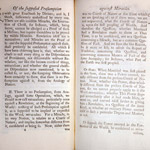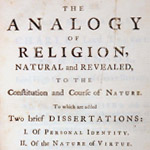 |
 |
Horace Walpole claimed Joseph Butler (1692-1752), Dean of St Paul's, was too intellectual, and believed he 'wafted in a cloud of metaphysics.' Despite Walpole's gossipy criticism, Butler's Analogy of Religion (1736) was an influential work, going through ten editions in England, and five in Scotland, during the eighteenth century. It was written as a defence of the Christian religion, with a special attack on the Deists and their belief that God did not reveal himself through prophets, visions, angels, and miracles. Cardinal Newman called Butler 'the greatest name in the Anglican Church.' This third edition is open at the chapter on miracles. |

